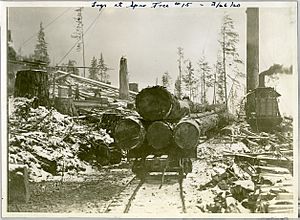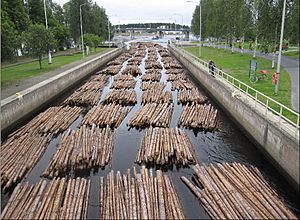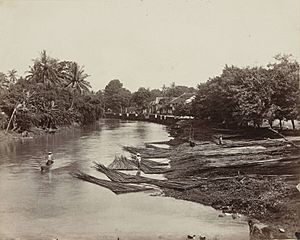Logging facts for kids
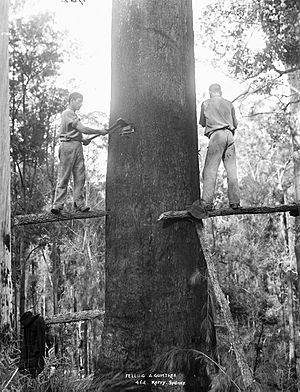
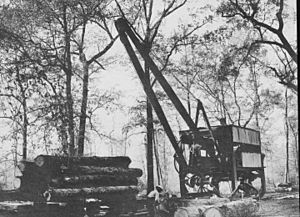
Logging is the process of cutting down trees and moving them out of the forest. It involves several steps. These steps include cutting the trees, moving them to a collection point, processing them on-site, and then loading them onto trucks or special train cars.
In the world of forestry, logging often means just the part where wood is moved. This is the journey from where the tree was cut to outside the forest, usually to a sawmill or a lumber yard. However, in everyday talk, logging can mean many different activities related to managing forests.
Sometimes, people talk about Illegal logging. This means cutting, moving, buying, or selling timber in ways that break the law. For example, it could be cutting trees without permission. It might also involve taking trees from a protected area. Cutting special protected types of trees is also illegal logging. Taking more timber than allowed by rules is another example.
Clearcutting is a method of harvesting trees. It is not always called a type of logging itself. Instead, it's a way of managing forests or harvesting timber. When companies log, the workers are often called logging contractors. Smaller groups of workers might be called "gyppo loggers."
Another method is called high grading. This means cutting only the most valuable trees. Less valuable trees, or those that are sick or misshapen, are left behind. This is sometimes confused with selection cutting. Selection cutting is a way of managing forests by carefully choosing which trees to harvest.
Logging usually happens above ground. But there are also "submerged forests." These are trees that were covered by water when reservoirs were created by dams. These underwater trees can be logged using special underwater logging methods. Sometimes, the water levels of the reservoirs are lowered to reach them. Ootsa Lake and Williston Lake in British Columbia, Canada, are places where this has happened.
Contents
What is Clearcutting?
Clearcutting, also known as clearfelling, is a way of harvesting trees. It involves removing almost all the trees in a chosen area. Forest managers decide if they want to leave some trees behind. These "reserve trees" can help with things like wildlife habitat. They can also help prevent erosion or protect water quality.
The main goal of clearcutting in silviculture (the art of growing and cultivating trees) is to help new trees grow healthy. This focus on forestry makes it different from deforestation. Deforestation is when forests are permanently cleared for other uses. Other ways of harvesting trees include shelterwood cutting, group selective cutting, single selective cutting, seed-tree cutting, patch cut, and retention cutting.
How Do People Log Trees?
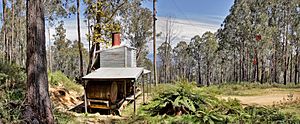
Logging operations can be done using different methods. Here are three main industrial methods:
Tree-Length Logging
In this method, trees are cut down. Then, their branches and tops are removed right where they fell. The main part of the tree, called the log, is then moved to a collection area. At this area, the log is cut into smaller pieces and loaded onto a truck. This method leaves the leftover branches and tops, called "slash," in the forest. This slash might need to be managed to prevent wildfires.
Whole-Tree Logging

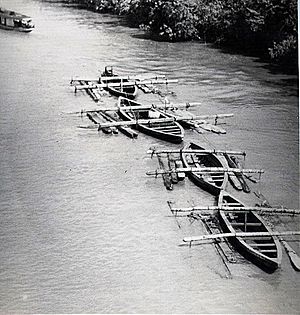
With whole-tree logging, trees are cut down and moved to the roadside. They are moved with their tops and branches still attached. Modern machines, called harvesters, can now cut, top, and remove branches from a tree all at once. This is thanks to new types of cutting heads.
Once at the roadside, the trees are then delimbed, topped, and cut into smaller logs. This method means the leftover slash is at the collection point. If there are facilities nearby that can turn waste into energy, the slash can be chipped. These wood chips can then be used to make electricity or heat. Whole-tree harvesting uses the entire tree, including branches and tops. This can remove nutrients and soil cover from the site. This might be harmful to the forest's long-term health if nothing else is done. However, many branches often break off during handling, so it might not be so different from tree-length logging.
Cut-to-Length Logging
Cut-to-length logging is a process where trees are cut down, delimbed, and cut into specific lengths. This all happens right where the tree fell. The branches and tops are left in the forest. Harvesters are machines that do all these steps. They then place the logs into piles. These logs are then picked up by a skidder or forwarder and taken to a collection point.
This method works well for trees up to about 900 millimeters (35 inches) wide. Harvesters are very useful on flat or gently sloped land. These machines are highly computerized. They can figure out the best cutting length for each log. They can also use GPS to control the harvesting area. They even use price lists for different types of logs to get the best economic results during harvesting.
Moving Logs to the Mill
After trees are cut, the logs are usually taken to a sawmill. There, they are cut into lumber. Or, they might go to a paper mill to be made into paper pulp. Logs can also be used for other things, like fence posts. Many ways have been used to move logs from where they were cut to a train line or directly to a mill.
The cheapest and oldest way is to use a river's current. Logs can float downstream by themselves, which is called log driving. Or, they can be tied together to form rafts. Some logs sink because they have a lot of resin; these are called "deadheads." In 1960, a special boat was built to help guide logs to the mill in Alaska.
In the late 1800s and early 1900s, a common method was the high-wheel loader. This was a set of wheels over ten feet tall. Logs were strapped underneath them. At first, oxen pulled these loaders. But in the 1930s, tractors took over from the oxen. In 1960, the biggest high-wheel loader was built in California. It was called the Bunyan Buggie. This machine could move itself. It had wheels 24 feet high and a front blade 30 feet wide and 6 feet high.
Moving logs can be difficult and expensive. Trees are often cut far from roads or rivers. Building and maintaining roads can be limited in places like National Forests. This is because roads can cause erosion near rivers. When logs are near a road, heavy machines can simply lift them onto trucks.
Often, special heavy equipment is used to collect logs from the cutting site. They move them closer to the road to be loaded onto trucks. Many methods exist to move logs that are far from roads. Cable logging uses a machine called a yarder. This machine pulls one or more logs along the ground to a platform where a truck is waiting. If the land is too bumpy to pull logs on the ground, a skyline can lift logs vertically. This is similar to a ski lift.
Heli-logging uses large helicopters to remove cut trees from forests. The trees are lifted by cables attached to the helicopter. This method is used when cable logging is not allowed for environmental reasons. It is also used when there are no roads. Heli-logging reduces the need for roads and other structures. This helps lower the environmental impact of logging. Less common or older ways of moving logs include using horses, oxen, or even balloon logging.
Images for kids
See also
 In Spanish: Industria maderera para niños
In Spanish: Industria maderera para niños


